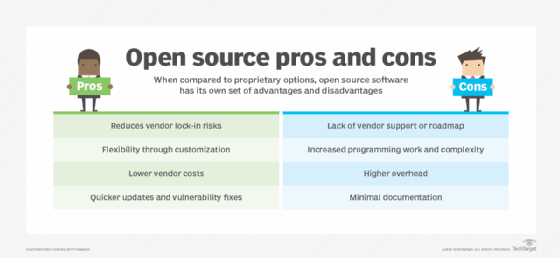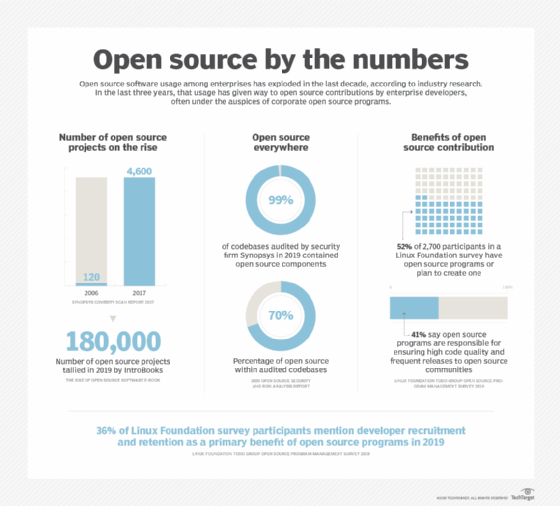
Sergey Nivens - Fotolia
5 advantages and 6 disadvantages of open source software
Open source software is popular with both small and large organizations, and for good reason. But CIOs should understand which situations works best for this lower cost option.
With all the benefits of open source software, the idea of paying for expensive vendor offerings seems counter...
Continue Reading This Article
Enjoy this article as well as all of our content, including E-Guides, news, tips and more.
intuitive.
Open source software has a number of advantages. But the software isn't without its downsides. IT leaders must carefully examine both the advantages and disadvantages of open source software to understand where it fits in their technology ecosystem.
What is open source software?
Open source software (OSS) has component code that's freely available to everyone. The software is typically developed collaboratively in open source projects by communities of collaborators, or contributors, as they're more commonly known.
The concept of open source software development stems from the earliest days of computer programming when tech-savvy programmers, particularly those in academia, shared code. Open source stems from the longstanding academic tradition of free and open knowledge exchange.
Today, OSS means programmers and developers can use, deploy or modify the code to suit their needs, typically for free. However, programmers and developers must adhere to specific terms of use as dictated by the open source license governing the open source software they're using.
Well-known open source packages include Apache, Audacity, Mozilla Firefox, Linux and WordPress. Some examples of open source vendors include Cloudera, Databricks, Mozilla, Puppet Labs and Red Hat.
On the other hand, proprietary software is commercial software that's sold, leased or licensed by its owner. This is usually a technology vendor who has paid for its development, creates all updates and therefore doesn't share the code that makes up its software. As such, proprietary software is also known as closed-course software or, to a lesser degree, nonfree software.

Who uses open source software?
Open source software is pervasive -- estimates put the use of free and open source software at 70% to 90% of modern software offerings, according to the Linux Foundation, a nonprofit consortium supporting the open source OS Linux. Moreover, open source code is part of OSes running across nearly all industries and in both the public and private sector.
A study by Forrester states that more than 50% of Fortune 500 companies use open source software for mission-critical workloads.
Moreover, its use is on the rise. Seventy-seven percent of surveyed organizations increased their use of OSS in 2021, according to the "2022 State of Open Source Report" from OpenLogic by Perforce and the Open Source Initiative (OSI), a nonprofit that promotes open source softwareOther findings include the following:
- Thirty-six percent of respondents reported a significant increase in the use of open source software.
- The technology sector represents the largest block of open source users. Consulting, the financial industry, the transformation sector, and telecommunications round out the top five users.
- Developers are the most common users of open source, but project managers, engineers, data scientists, tech executives and operations leaders also use open source.
Open source software advantages
In its 2022 "The State of Enterprise Open Source" report, Red Hat found that 82% of the 1,296 surveyed IT leaders said they're more likely to select a vendor who contributes to the open source community.
The report found that many IT leaders preferred enterprise open source vendors for the following four reasons:
- They're familiar with open source processes.
- They help sustain healthy open source communities.
- They can influence the development of needed features.
- They'll be more effective if technical challenges emerge.
In addition, the report found that 89% of IT leaders believe enterprise open source is as secure or more secure than proprietary software.
Indeed, CIOs, IT leaders, developers and others in the technology field have identified multiple benefits of open source.

1. It's cost-effective.
Open source software is usually lower in cost, though it is not always completely free to use and modify. Its use generally has some attached strings, spelled out in the licensing agreements.
Still, in an apples-to-apples comparison, the cost to use OSS is less expensive than buying commercial software.
2. It enables agility, flexibility and speed.
Because the source code is readily available and openly shared, developers can quickly access it and start working. It also brings a high degree of agility and speed to organizations by enabling them to quickly create new software functions and features in response to market changes and evolving needs. And because open source software doesn't come with contracts, IT teams are able to sidestep the issue of vendor lock-in.
With proprietary software, organizations must first negotiate contracts before implementing the software. They must then work with vendors to either request or buy upgrades and new features not included under the contract terms.
3. It's easier to start pilot programs and scale as needed.
Quick and easy access to source code and its nearly nonexistent costs enable organizations to more easily try out and pilot computer programs built on open source software. Those attributes also enable organizations to scale more efficiently, as they can build out as they see the need arise.
4. It has a large, diversified community.
Open source software is managed, maintained and advanced by communities of contributors. These user-friendly communities often have contributors from various companies in different industries operating around the world, typically working in what's known as a collaborative development environment. As such, organizations using open source often can draw on the community for support and benefit from the innovation all those minds bring to the project.
That point doesn't seem lost on CIOs: Red Hat's report found that 54% of surveyed IT leaders use open source for digital transformation initiatives. Other reasons include IT infrastructure modernization (62%), application development (52%) and application modernization (48%).
5. It attracts tech talent.
Organizations that use open source software often have an edge when competing for hard-to-find tech talent, according to the OSI and other sources. In addition, some technologists prefer work that involves open source software.
Disadvantages of open source software
Using OSS also presents challenges for many enterprise IT teams and organizations. Not addressing these difficulties early in the process can limit the benefits of a development program, reduce ROI or even cease entire initiatives.
IT leaders should consider the following challenges before selecting open source software.
1. There may be unexpected costs.
Although many observers equate open source software with no cost, there are some upfront costs associated with its use. Organizations must also invest in talent with the proper training and capability to work with and support open source. There are also costs associated with deploying, integrating and managing open source that many organizations either fail to consider or underestimate in their cost calculations.
In other words, even if there are no upfront costs, there are ongoing costs. As a result, IT management advisors stress the need to calculate and consider that TCO is the better value when selecting an open source or commercial option.
2. You may underestimate resource requirements.
On a similar note, organizations often underestimate the skills required to use open source software and the time their IT talent will have to devote to the task.
According to the Linux Foundation's "2021 Open Source Jobs Report," 97% of hiring managers said hiring open source talent is a priority. Yet 92% face difficulty hiring and retaining talent.
Forrester Consulting exposed other staffing challenges in its April 2021 "Seize The Open Source Opportunity Through Comprehensive, Optimized Strategies" report commissioned by Perforce. For example, the report noted, "when companies fail to create and align behind optimized, comprehensive strategies, they struggle to hire and retain high-end talent who prefer OSS environments."
3. There may be trouble with implementation, integration and scaling.
IT teams may find it difficult to integrate open source software into the enterprise IT ecosystem. For example, there are a number of challenges associated with open source, including the following, according to the "2022 State of Open Source Report" from OpenLogic by Perforce and the OSI:
- implementation, upgrades, and configuration issues
- internal skills to support the software
- integration and interoperability concerns, and
- infrastructure scalability and performance.
4. There may be unknown, orphaned source code.
Because open source is so easy to access, it can make its way into enterprise use without good oversight and governance. As a result, organizations may not know or lose track of the open source code running within their IT environment.
In addition, organizations may have open source code that's no longer maintained by a community of contributors, leaving it orphaned without support.
Those scenarios can create problems for organizations. An IT team discovering a security flaw is particularly problematic. For example, they won't be able to properly manage, maintain and update open source code they don't know is present or that's unsupported.
5. The amount and complexity of license rules and requirements.
There are dozens of open source licenses. The OSI offers a breakdown and details on those it has approved.
Some license requirements can be technically complex. For example, some require developers to share any changes they make to the source code. Some have patent retaliation restrictions, while others limit or prohibit the use of open source software in products for commercial sale. Moreover, developers using more than one OSS in a product could find that the license terms for one open source component contradict the license terms associated with another.
Organizations must know, understand, manage and meet all license rules and requirements of the OSS they use. Unfortunately, it's a task some view as a downside to open source software use.
6. There's an absence of vendor support.
Communities of contributors create a large pool of OSS expertise. But those communities aren't equivalent to contractually obligated vendor support with stipulated service-level agreements.
CIOs, IT teams and the organizations they serve must be clear on that distinction.
The reality is that open source does not come with ready-made, 24/7 support. IT departments must be prepared to navigate challenges mostly or entirely on their own.






